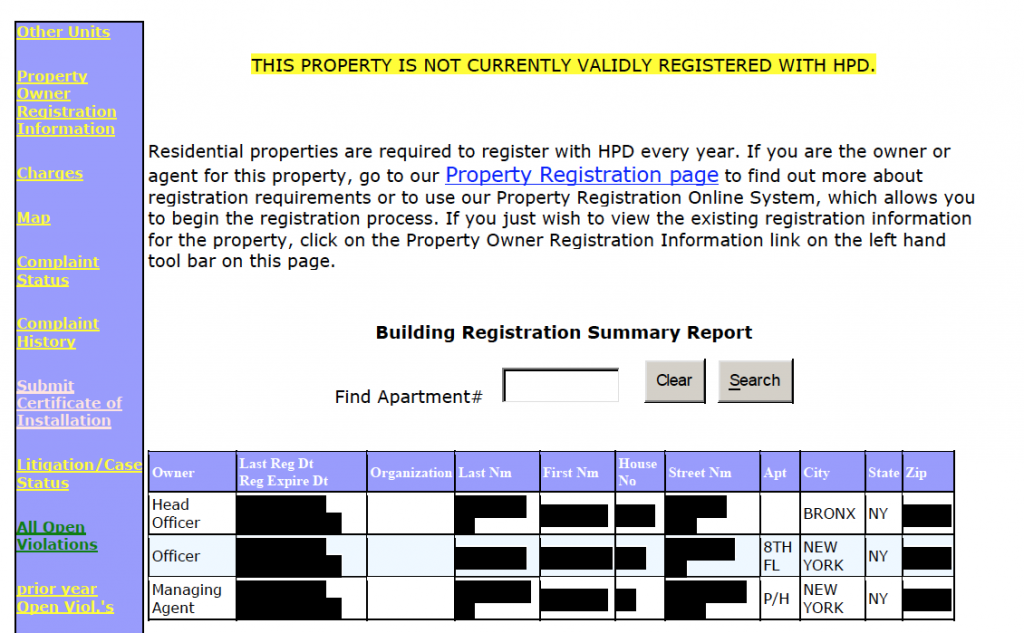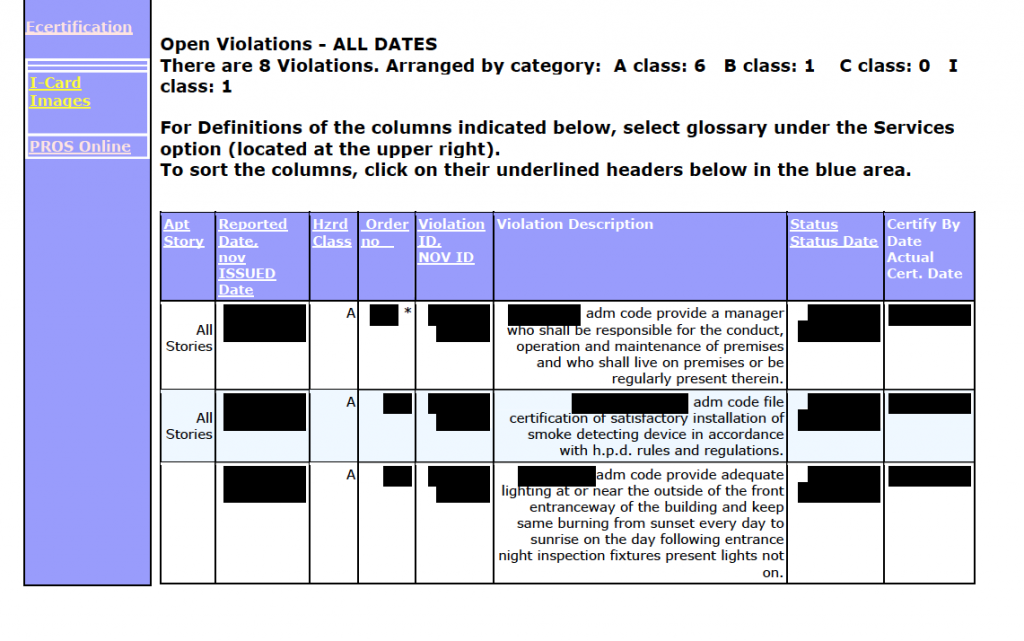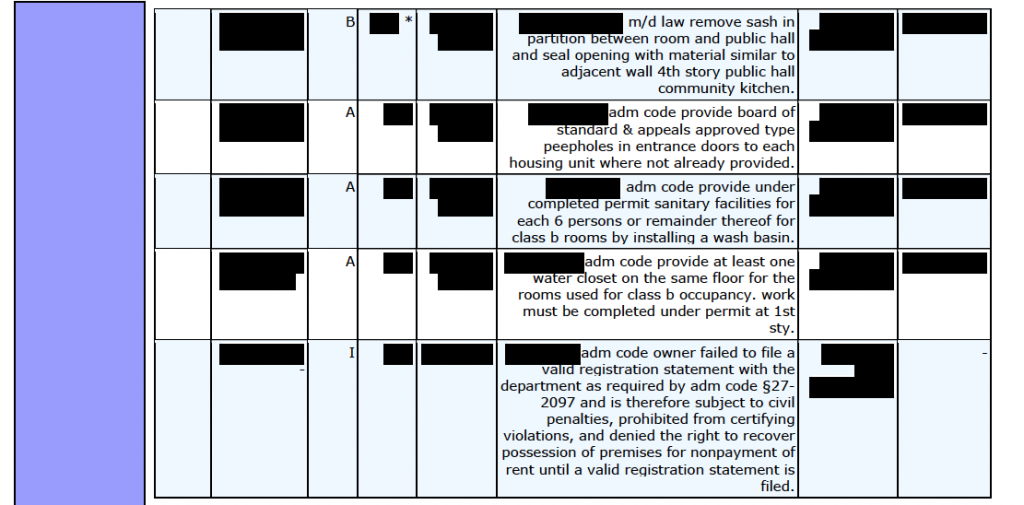Adam Leitman Bailey, P.C. Due Diligence Report 10
DUE DILIGENCE REPORT
Prepared By
Adam Leitman Bailey, P.C.
120 Broadway, Seventeenth Floor
New York, New York 10271
(212) 825 – 0365
alblaw.wpengine.com
May 5, 2015
SCOPE OF DUE DILIGENCE RESEARCH
The due diligence research on [redacted] in Manhattan, New York (Block [redacted] Lot [redacted]) reported below was conducted for the sole purpose of advising on the rent regulatory status of the building and its units, providing the building’s litigation history and most importantly, determining whether the Department of Housing and Preservation Development of the City of New York (“DHPD”) ever investigated the building for the purpose of issuing a Certificate of No Harassment (“CONH”), the instrument necessary to enable your plans to change the use of the building. The scope of our research keeps in mind your ultimate goal of converting the building to a two family rental building and providing leverage useful in negotiating a purchase price.
You advised that the entire building is solely occupied by prior owners, [redacted] and [redacted], used as a single family home and owned by an entity who purchased the building in a foreclosure proceeding in April 2015. Online research revealed the building is marketed for sale as being a single family townhouse with 7 bedrooms and four bathrooms.
If the [redacted] have not paid rent to the current owners, then under the Real Property Actions and Proceedings Law, they can be evicted relatively easily since the property was sold in foreclosure and a foreclosure judgment against them was executed. Note that a summary proceeding to evict the owners is still necessary if they do not vacate voluntarily. There is no way to be sure how long that it will take to obtain a possessory judgment and warrant of eviction against them as it depends on many variables, including whether they default in the proceedings, or perhaps, appear and string the litigation along then perhaps file an appeal. We estimate holdover proceedings of this type to cost between $5,000 and $10,000 in legal fees, but again unforeseeable motions, frivolous or not, can cause the legal fees to exceed $10,000, at times.
INVESTIGATIVE FINDINGS AT DHPD
Even if the [redacted] are successfully evicted or vacate voluntarily, a Certificate of No Harassment is the single most critical element to effectuate your plans to convert the building to a two family rental building.
According to [redacted] of the DHPD Certificate of No Harassment Unit, over the last ten years, the owner of this building has never filed an application for the issuance of a Certificate of No Harassment. City agencies, including the NYC Department of Buildings and DHPD, will not allow the conversion to a two family house to take place unless and until DHPD investigates and determines the history of tenant harassment, if any, at the building. The significance, to you as a prospective buyer, of no CONH history with DHPD is that there is no way of knowing whether there is a history of tenant harassment at the building other than to interview the seller, prior owners and in this case, the current occupants, [redacted] and [redacted]. Of course, there is no reason to suspect that anyone other than the seller will be particularly cooperative.
As more fully explained below, the DHPD’s investigation examines the period thirty-six months prior to the date that the CONH application is filed. If the [redacted] have been the sole occupants for the last thirty-six months, it is very likely that DHPD will have no choice[1] but to issue the CONH, unless it locates prior tenants and finds that they were harassed by the [redacted] —an unlikely event.
Firmly confirming and determining when and how the [redacted] came to be the sole occupants of the building directly relates to whether DHPD will issue a CONH for the building. For instance, if the [redacted] have been the owners and sole occupants since the 1980’s, then DHPD will have no choice but to issue a CONH. However, public records are not consistent with that possibility.
The Building’s History of Single Room Occupancy Status and Its Repercussions
According to the latest HPD Multiple Dwelling Registration filed by the previous owner, [redacted], on or about February 16, 2006, the building, presumably at that time, consisted of 4 Class A and 8 Class B residential units spread over 4 stories.[2]
On the 2006 multiple dwelling registration, the building is classified as a “Class P” multiple dwelling, which is defined by DHPD as a multiple dwelling that was “heretofore converted Class “B” multiple dwelling.” A “Class B” multiple dwelling is a multiple dwelling which is occupied transiently, i.e. more or less the temporary abode of individuals or families with or without meals. As you may know, a multiple dwelling registration is a filing that is unilaterally submitted by the owner to DHPD. That filing is not challenged unless and until an issue arises that, say, causes a tenant or the City to question why the owner designated the building as a Class P multiple dwelling. Therefore, it very well could be that [redacted] undertook illegal alterations to create a single family home after the Class A and Class B tenants moved out, then registered the building in 2006 as a Class P multiple dwelling. The only means of finding out the full story is to hear it from the [redacted]. The Department of Buildings Buildings Information System site shows no history of construction converting the building to a single family home. Notably, the BIS site still characterizes the building as a landmarked, SRO restricted building.
We recommend you walk through the building prior to contract to confirm the building’s current physical layout, single family use and sole occupancy by the [redacted]. We also recommend you require the seller, or perhaps obtain from the [redacted] directly, a detailed explanation and documentation, if any, as to just exactly how the building came to be its current layout. The bottom line is to determine how it went from a purported 12 unit building to a building fit for single family use. Questions to ask the seller/the [redacted] include at a minimum:
- When was the building last occupied by tenants other than the [redacted]?
- Were those tenants evicted? · What construction did you perform to create a single family home?
- Was that construction legal with all necessary Department of Buildings permits and approvals in place?
Knowing the building’s full history is necessary towards obtaining the Certificate of No Harassment necessary to effectuate your plans to converting the building to a two family rental.
The Foreclosure Proceeding
Our court investigations revealed no litigation history related to the building or its owners other than the foreclosure proceeding which we were aware of. The [redacted] originally defaulted in answering the foreclosure complaint. Then, mid-litigation, [redacted] attempted to stop, or more accurately stall, the foreclosure proceeding, claiming the note holder failed to provide the proper pre-litigation notices. That motion was denied because [redacted] did not appear at oral argument. The proceeding named “JOHN DOE” and “JANE DOE” as tenants of the building which indicates that the note holder could not identify, by name at least, the tenants of the building at the time the foreclosure case was commenced. The use of “Doe” may well indicate that the Plaintiff was not aware of there being any tenants and was simply following a procedure with no real meaning. The foreclosure case file did not offer any information useful for our due diligence purposes.
Background on Single Room Occupancy Law
To fully understand the consequences of the building’s SRO restricted classification, we provide the following background on Single Room Occupancy law.
The Multiple Dwelling Law defines single room occupancy as “the occupancy by one or two persons of a single room, or of two or more rooms which are joined together, separated from all other rooms within an apartment in a multiple dwelling, so that the occupant or occupants thereof reside separately and independently of other occupant or occupants of the same apartment.” The 2006 DHPD multiple dwelling registration shows the building to have 8 Class B, or single room occupancy units.
Understand that the Class B multiple dwelling is occupied as an SRO unit when an SRO tenancy is created. Generally speaking, SRO tenancies are created under oral agreements and do not have written leases. The most common way an individual becomes a permanent, SRO tenant is to reside in the building continuously for at least six months as a principal residence, or simply request a lease for a period of six months or longer, which the owner must provide within 15 days or reside in the building pursuant to a lease of six months or more lease, even if actual occupancy is less than six months. Unfortunately for building owners, this type of occupancy too easily gives rise to the creation of permanent tenancies with “special” rent stabilization protections.[3]
In processing CONH applications, the inquiry period HPD uses is for the thirty-six months prior to HPD accepting your application or, if an owner makes an alteration or demolition application to the DOB, thirty-six months prior to the date the owner applied. The inquiry period ends when HPD makes a final determination. During the inquiry period, HPD investigates any evidence of harassment which if found, would then call for an administrative hearing on whether the owner/prior owner harassed the tenants in order to vacate the building.
Important Recommendations for a Successful CONH Application
You may apply for the CONH as a contract vendee if you are in possession of the property and if you can show DHPD proof of sufficient property insurance. Any harassing conduct committed by any prior owner HPD will use against you by when it considers your application. This is precisely why it is critical to follow the recommendations set forth in this report. Again, if the [redacted] have been the only occupants of the building for the last thirty-six months then we do not anticipate DHPD will deny your application. If you find out that tenants other than the occupied the building, our most critical recommendation is to obtain an affidavit:
- Sworn to on a date as close to your closing date or application date as possible;
- From each SRO tenant;
- Stating that each such tenant has never been harassed during such tenant’s tenancy
- Setting forth in the Affidavit the starting date and ending date for that tenancy.
As previously mentioned, the mere request for a lease for a six month period or more creates a permanent SRO tenancy, which is precisely why our second most critical recommendation is to ensure that the seller does not allow any new occupants into the building whatsoever. Needless to say, you should ensure that the seller is prohibited from entering into any new leases once the contract is signed. Similarly, you should ensure that the Seller has not accepted any rent from the [redacted] since it purchased the building in April 2015. Acceptance of rent creates a landlord tenant relationship and hinders the potential for a relatively simple eviction proceeding.
For your convenience and ready reference, annexed hereto as Exhibit “1” is a copy of the application for a CONH together with submission instructions.
The Division of Housing and Community Renewal of the State of New York (Lack of Rent Registrations)
The owner of an SRO building is required to register the SRO rents with the Division of Housing and Community Renewal of the State of New York (“DHCR”). If you decide to purchase this building, we recommend you obtain a letter of authorization from the seller allowing our office to obtain the DHCR Rent Registration Report and Case List for this building. That report will provide information of the rent stabilized and SRO tenancies in the building, assuming the owner complied with the registration requirements of the rent stabilization law.
New York City Violations Issued Against the Building
NYC Department of Buildings (DOB)
Overview of the Building
The Department of Buildings classifies this building as “C4-Walk Up Apartment”. This is a Department of Finance classification used to classify the premises’ tax status, as distinct from its legal use which is typically set forth in the Certificate of Occupancy. There is no Certificate of Occupancy for this building on file with the DOB. As previously advised, a walk-thru and inspection of the building is highly recommended and necessary to verify the use of the building and confirm exactly what is the layout of the building.
A Certificate of Occupancy would indicate the legal use of the property, i.e. commercial, residential, storage, garage use). The lack of a Certificate of Occupancy indicates that the building was constructed prior to 1938, and that there has been no change in use of the property nor have there been any additions to the building. Nineteen thirty-eight is when the City began to require property owners to file a Certificate of Occupancy application if construction or alteration changed their building’s use, occupancy, or means of exit.
In lieu of a Certificate of Occupancy, an owner or prospective buyer may obtain a Letter of No Objection to confirm the legal use of the building. For your convenience, we provide below a link to details regarding obtaining a Letter of No Objection from the Department of Buildings.
Open DOB Violation
There is one open, February 1997 DOB boiler violation (Violation No. [redacted]). You can view the open violation online using the New York City Department of Buildings’ Buildings Information System (“DOB BIS”) located [redacted] at You can easily access that site by conducting a Google search on “Building Information System.” You should require the seller correct, or if already corrected, certify and pay any imposed fines prior to closing or alternatively, ensure you receive a credit for the cost of correcting violations that are open on the date of closing.
Department of Housing Preservation and Development of the City of New York (“HPD”)
Provided below are is a screenshot of the Building’s Registration Summary Report followed by the open HPD violations as of May 4, 2015.
Notably, the 2015 open violation for failure to file a multiple dwelling registration is not likely to deter DHPD from issuing a CONH because it is an administrative error as opposed to a violation relative to harassing tenants, such as a no heat/no hot water violation.
Nonetheless, it may be worth your while to negotiate a credit for each of the open HPD violations or have them resolved by the closing date and demand proof of payment for all associated administrative fees, if any. When you conduct the pre-closing walk-thru of the building, you should confirm that each violation has been corrected and photograph each repair.
Property Shark Report
The Property Shark Report for the building, which includes information pertaining to the neighborhood, ownership, property tax assessment, zoning and size, is provided as Exhibit “2” to this report.
Landmark Designation
We must remind you that we have determined that this building is a designated landmark. Such designations always entail restrictions on what an owner can do with the property, particularly with regard to renovations of the property. The designations of buildings as landmarks vary considerably as to the B * m/d law remove sash in partition between room and public hall and seal opening with material similar to adjacent wall 4th story public hall community kitchen. A adm code provide board of standard & appeals approved type peepholes in entrance doors to each housing unit where not already provided. A adm code provide under completed permit sanitary facilities for each 6 persons or remainder thereof for class b rooms by installing a wash basin. A adm code provide at least one water closet on the same floor for the rooms used for class b occupancy. work must be completed under permit at 1st sty. – I adm code owner failed to file a valid registration statement with the department as required by adm code §27- 2097 and is therefore subject to civil penalties, prohibited from certifying violations, and denied the right to recover possession of premises for nonpayment of rent until a valid registration statement is filed. – extent of the prohibited changes to the building. While the most common restrictions have included changes to the façade of the building, this office has come across far more intrusive restrictions, including interior restrictions such as the kinds of permissible plumbing fixtures in the building. It is therefore necessary to thoroughly research just how restricted the designation of this particular building is, something which is outside of the scope of this report, but which this office would be pleased to do on your behalf if you so desire. In any event, you should take note that you should not assume that your plans for the building will be without difficulty encountered at the Landmarks Preservation Commission. We also note in passing that of all the agencies in the United States of America, decisions of the New York City’s Landmarks Preservation Commission enjoy the dubious distinction of nearly never being overturned by a Court. Thus, if there is something that you contemplate that runs afoul of the Landmarks Commission, to all intents and purposes, the Commission’s decision will be absolutely final.
CONCLUSION
This is, for this office, an unusually terse due diligence report given its limited scope. While we cannot answer the question as to whether the contemplated price for this building will return a fair value, the observations provide you with further leverage in your negotiations. We have concerns about the history of the building insofar as it will impact your ability to do with the building as you wish, concerns, but relatively low end concerns. The eviction of the current occupants, while it could be a somewhat costly chore, is relatively assured. However, the issues regarding the CONH and Landmark designation are not assured and are rather special risks associated with this building.


